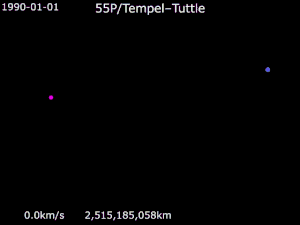55P/Tempel–Tuttle
55P/Tempel–Tuttle (commonly known as Comet Tempel–Tuttle) is a periodic comet with an orbital period of 33 years. It fits the classical definition of a Halley-type comet with a period of between 20 and 200 years. It was independently discovered by Wilhelm Tempel on December 19, 1865, and by Horace Parnell Tuttle on January 6, 1866.
| Discovery | |
|---|---|
| Discovered by | Wilhelm Tempel and Horace Parnell Tuttle |
| Discovery date | December 19, 1865 |
| Alternative designations | 1366 U1; 1699 U1; 1699 II; 1865 Y1; 1866 I; 1965 M2; 1965 IV; 1965i; 1997 E1 |
| Orbital characteristics A | |
| Epoch | March 8, 1998 (JD 2450880.5) |
| Aphelion | 19.6924 AU |
| Perihelion | 0.9766 AU |
| Semi-major axis | 10.3345 AU |
| Eccentricity | 0.9055 |
| Orbital period | 33.2226 a |
| Inclination | 162.486° |
| Earth MOID | 0.008 AU (1,200,000 km)[1] |
| Last perihelion | February 28, 1998 |
| Next perihelion | May 20, 2031[2][3] |
It is the parent body of the Leonid meteor shower. In 1699, it was observed by Gottfried Kirch[4] but was not recognized as a periodic comet until the discoveries by Tempel and Tuttle during the 1866 perihelion. In 1933, S. Kanda deduced that the comet of 1366 was Tempel–Tuttle, which was confirmed by Joachim Schubart in 1965.[4] On 26 October 1366, the comet passed 0.0229 AU (3,430,000 km; 2,130,000 mi) from Earth.[5]
The orbit of 55P/Tempel–Tuttle intersects that of Earth nearly exactly, hence streams of material ejected from the comet during perihelion passes do not have to spread out over time to encounter Earth. The comet currently has an Earth-MOID of 0.008 AU (1,200,000 km; 740,000 mi).[1] This coincidence means that streams from the comet at perihelion are still dense when they encounter Earth, resulting in the 33-year cycle of Leonid meteor storms. For example, in November 2009, the Earth passed through meteors left behind mainly from the 1466 and 1533 orbit.[6]
In February, 2016, two bolides detected by the NASA All-Sky Fireball Network were calculated to have orbits consistent with those of 55P, although with a node 100 degrees less than 55P. The reason for this is yet to be determined.
55P/Tempel–Tuttle is estimated to have a nucleus of mass 1.2×1013 kg[7] and radius 1.8 km[7] and a stream of mass 5×1012 kg.[7]


See also
- Comet IRAS–Araki–Alcock (Comet close approach 1983)
- Lexell's Comet (Lost comet close approach in 1770)
- 252P/LINEAR (Close approach 2016)
- P/2016 BA14 (Close approach 2016)
References
- "JPL Small-Body Database Browser: 55P/Tempel-Tuttle" (last observation: 1998-07-05). Jet Propulsion Laboratory.
- Seiichi Yoshida (12 December 2005). "55P/Tempel-Tuttle". Seiichi Yoshida's Comet Catalog. Retrieved 18 February 2012.
- "55P/Tempel-Tuttle Orbit". Minor Planet Center. Retrieved 16 June 2014.
- C&MS: 55P/Tempel-Tuttle
- "Closest Approaches to the Earth by Comets". Minor Planet Center. Retrieved 28 June 2012.
- BBC News (17 November 2009). "Star gazers hoping for clear sky". Archived from the original on 17 November 2009. Retrieved 17 November 2009.
- David C. Jewitt. "From Cradle To Grave: The Rise and Demise of the Comets" (PDF). Comets II. Retrieved 12 November 2009.
External links
- Orbital simulation from JPL (Java) / Horizons Ephemeris
- Gary W. Kronk's Cometography
| Numbered comets | ||
|---|---|---|
| Previous 54P/de Vico–Swift–NEAT |
55P/Tempel–Tuttle | Next 56P/Slaughter–Burnham |

